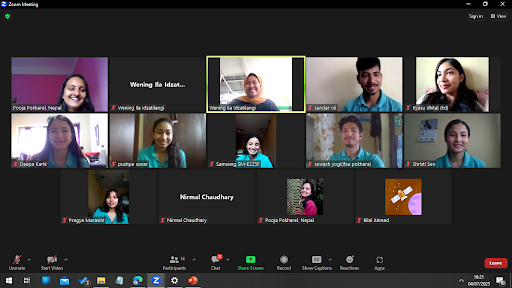Nepal’s Cultural Day
The Roof of The World
On Tuesday, 04 June 2023, 7-9.15 AM (UTC+0) The International Forestry Students’ Association of Local Committee Pokhara hosted the cultural day via Zoom meeting. The presenters were (alphabetically): Cyasupia Dhital, Dipa Karki, Niruta Singh, Pooja Pokharel (Moderator), Pragya Marasini, Pushpa Sunar, Shristi Sen, Sundar Oli, and Suwash Yogi (LC Pokhara President). The presentation began with an explanation of the geography of Nepal. Technically, Nepal is located in a locked condition that is nestled in the Himalayas between China to the north and India to the south, east, and west. This country is also known for having mountainous conditions and is characterized by rolling hills and valleys, deep valleys, and rivers. This condition leads to a crisscrossed river condition that originates from the Himalayas; those major rivers are Koshi, Gandaki, and Karnali. These big rivers then give big benefits for the people in terms of agriculture also creating such a megadiversity of flora and fauna.
Aside from its megadiversity, the forest management of Nepal has a long history. Before 1926 A.D. forests were managed mainly for hunting purposes. The land was given as a reward to the officials by the name of Birta, Guthi, Keepat, etc. Seeing many wood potencies, Kath Mahal Office was established in 1927 to govern the sale of timber to India and other incomes from forests. Time goes by, and the government indicates that they must fragment the forest area into the production area, conservation area, and reserve area. To advance the proposal, the Institute of Forest was established in 1973. The government reconstruction of policies happened in 1988, officially being discussed at the first national seminar on community forests. Just in the next year, the forest development Forestry Sector Master Plan was released. After the political revolution in 1990, people’s participation increased. Rules and regulations under the forest act were made, and a Forest User Group (FUG) was formed. The national forest is legally fragmented depending on their assigned management which is: community forest, leasehold forest, government-managed forest, religious forest, and protection forest. The forest legal fragmentation is one of the best decisions as we know the number of deforestation in Nepal in the past was high enough. The conservation of forests in Nepal especially in wildlife must be appreciated as this is the first country that can double its tiger population in the last twelve years.
Move into Nepal’s culture, there are a lot of festivals that are celebrated almost every month. All the festivals have their own history. Please check the pdf below to see and get more insights about Nepal as there are a lot of visualizations given. Lastly, IFSA LC Pokhara is also promoting itself for hosting the Asia Pacific Regional Meeting 2024. Once you see the presentation, you know if they are one of the best countries you must ever visit in your life.
Presentation: Cultural Day Nepal( 2023).pptx.pdf
Author: Wening Ila Idzatilangi


